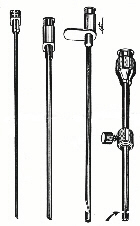- To the Editor:
When a pleural biopsy is performed, the thoracentesis is made with
the outer cannula of the pleural biopsy needle. The two types most frequently used are
Cope's (1) needle and Abram's(2) needle; both have been shown to gave the same efficiency(3).
During thoracentesis, the negative pressure can cause the aspiration of lung tissue,
resulting in obstruction of the distal hole of the outer cannula and interrupting the
drainage. The change in the position of the outer cannula does not always help to
prevent this phenomenon.
We have proposed a modification in the outer cannula of Cope's needle to solve this problem.
Four holes, diametrically opposed, each one 1 mm in diameter and located 2.5 mm from
the distal extremity, are made around the outer cannula (Figure 1). These extra holes allow drainage even when
the distal hole is obstructed.

REFERENCES
(1) Cope C, Bernhardt H. Hoo-needle biopsy of pleura, pericardium, peritoneum and synovium. Amer J Med 1963;35:189-95.
(2) Abrams LD. A pleural biopsy punch. Lancet 1958; 1:30-01.
(3) Morrone N, Algranti E, Barreto E. Pleural biopsy with Cope and Abrams needles. Chest 1987; 92:1050-02.
Roberto de Menezes Lyra. IAMSPE Serviço de Cirurgia Torácica São Paulo, Brazil.


 Published Letters
Published Letters